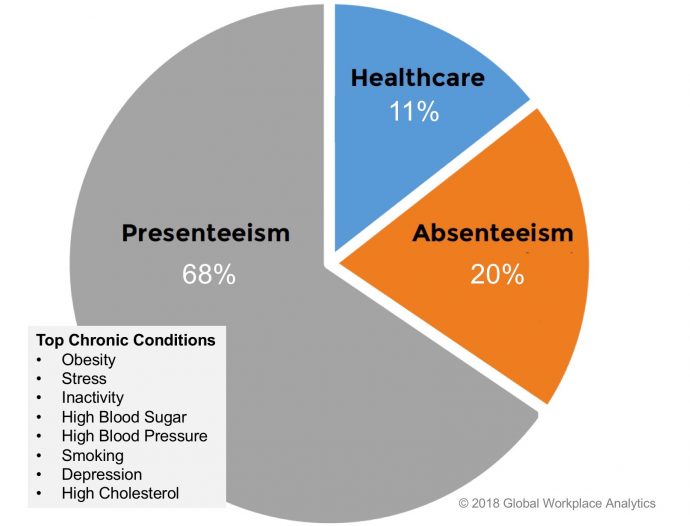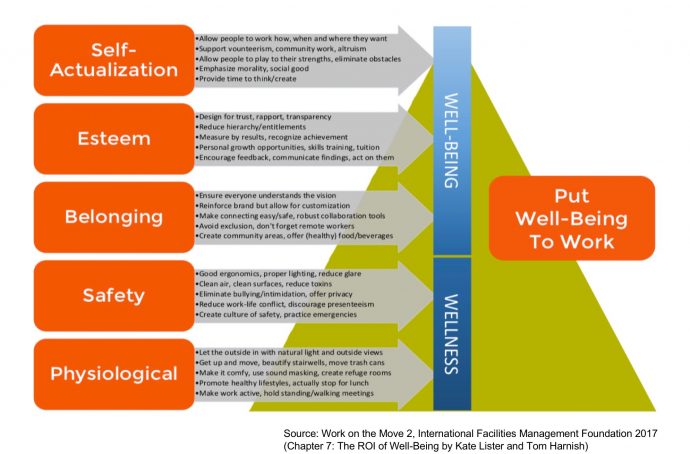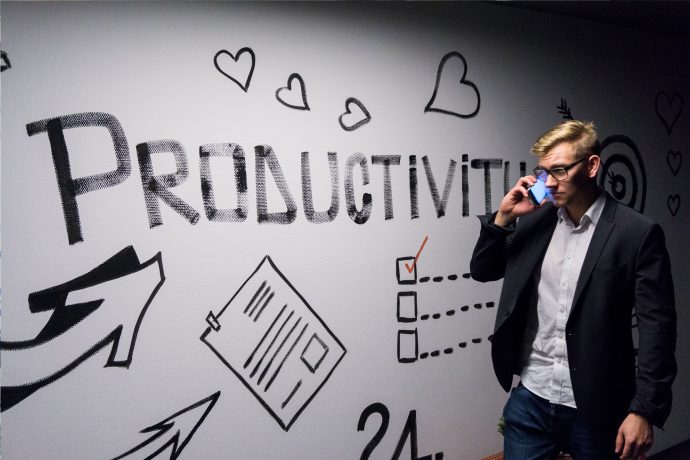Kate Lister breaks down the impact of the workplace on well-being and the steps to take to create a culture of well-being.

Well-being is hard to see. Many say it’s hard to measure too. To those who do, I say ‘horsepucky.’ The impact of workplace changes on well-being can and should be measured. Paradoxically, while few business leaders demand an ROI for the $5,500 per person per year they spend on health coverage, most will insist on a cost justification for initiatives such as onsite healthcare, stress counseling, or a healthy building investment. So let’s look at the dollars and sense of well-being.
Imagine you’re a manager and Janice, one of your star performers, flags you down at the coffee bar to tell you she’s taking an extra 20 days off this year to deal with stress. Joe’s right behind her, he’ll be off an extra 50 days because he isn’t engaged in his work. A line is forming now, with others queueing up to let you know the number of days they’ll be gone too. Nope, it’s not April Fool’s Day; it’s your employees being honest about the impact of well-being on human performance.
The Link Between Health and Productivity
The Centers for Disease Control reports that 68 percent of the workforce has at least one chronic health condition. If you add obesity to the list, that number jumps to 86 percent; nearly nine out of 10 workers! [1] Research by Gallup shows that someone with one or more chronic diseases has between three and 10 times more unhealthy days a month—defined as days they can’t conduct their usual activities (like, say, going to work).[2]
In total, the top eight chronic conditions rob a typical employer of 44 days a year for every 1,000 employees.* That’s like having two out of every 10 employers doing nothing but watch YouTube videos every hour of every day.
*Per Global Workplace Analytics’ Well-Being Savings Calculator™ based on data from peer reviewed research on costs per chronic condition
Let’s use stress to demonstrate the math behind those numbers. About 43 percent of the workforce suffers from chronic stress.[3] As shown in Figure 1, on average, they individually lose the equivalent of 10 days of productivity a year due to absenteeism and another 12 days a year due to presenteeism (see sidebar).[4]
Sidebar:
Presenteeism is defined as being at work but not performing your best. The World Health Organization and Harvard Medical School figured out how to measure it more than a decade ago. Their Health Performance Questionnaire tracks the global burden of disease in healthcare, absenteeism, and presenteeism costs. Harvard Medical School has validated the results against actual work outcomes.
Best of all, it’s free.
Figure 1. Per Person Cost for Top Chronic Conditions

Someone suffering from depression (7 percent of the workforce) loses an average of seven days a year to absenteeism and a whopping 36 days to presenteeism.
So while employers wring their hands over the high cost of healthcare, the elephant in the room—weighing in at eight times that cost—is the cost of lost productivity due to poor well-being (see Figure 2).
Figure 2. Breakdown of Employer Costs for Top 8 Chronic Conditions

Well-Being and Employee Engagement
You’d have to be living under a rock to have not heard about the dismal state of employee engagement, but what you may not have heard is what that means in terms of employee well-being.
According to Gallup, employees in the highest quartile of engagement are 21 percent more productive (than those in the lowest quartile), and they call in sick 37 percent less (than those in the lowest quartile).[5]
Which is cause and which is effect is hard to gauge, but the opposite is also true. Low engagement is linked to poor health.[6] Gallup finds that disengaged employees are:
- Two times more likely to have three or more unhealthy days a month,
- Eight times more likely to suffer from depression,
- Less than half as likely to say they are in “excellent” health,
- Four times more likely to have high blood pressure,
- Three times more likely to be obese,
- Three times more likely to have diabetes, and
- Two times more likely to have high cholesterol.
Using some of the above data, we can easily calculate the financial impact of low engagement. More on that in a bit.
Employer’s React (or not)
The good news, for both employers and employees, is that eight out of 10 chronic conditions can be prevented or reversed with lifestyle changes.[7] And since a third of a person’s waking hours are typically spent at work, employers are in a good position to do something about it. But while they overwhelmingly agree that wellness programs help increase productivity and reduce costs,[8] only one in 10 employers offer what’s considered to be a comprehensive well-being program (i.e. one that targets interventions, offers incentives, is open to spouses, and tracks progress).[9]
The biggest roadblock is getting executive buy-in. Program champions are rarely equipped to present a compelling business case for wellness initiatives. And even those who understand the numbers are hard-pressed to prove the connection between the intervention and the result. The CFO will argue that engagement went up or absenteeism/presenteeism went down because of a better economy, a reorganization, or the bonuses employees just received.
That’s a tough argument and one that many in the wellness businesses face. My approach is to turn the question on its head and instead of trying to prove ROI, let a breakeven analysis make the no-brainer business case.
Using a Breakeven Analysis to Make the Business Case for Well-Being
Let’s use an investment in the WELL Building Standard* as an example. One of the early WELL Certified building projects added about $150,000 in cost, over and above Gold LEED. The building accommodated about 200 people. Based on a 15-year amortization, that’s $10,000 per year investment. Figure 3 shows what it would take to breakeven on that investment based on a reduction in chronic conditions, or increases in productivity or engagement.
*The WELL Building Standard was created by the International WELL Building Institute™
Figure 3. Breakeven Analysis on WELL Investment

What it shows is that if, as a result of the investment in WELL, less than one person brings their weight down to the recommended level or doesn’t become obese, the entire investment will pay for itself.* Likewise, if 1.2 persons stopped being inactive, or 0.3 people didn’t have to leave the company for health reasons,** the entire cost would be offset.
*The savings would be $10,800 (the healthcare, absenteeism, and presenteeism per person cost for obesity) and the amortized cost of the WELL additions is 10,000 a year.
**Experts put that number at between 35 percent and 200 percent of salary; the assumption here is 50 percent of salary.
It also shows that if employees gain just a few seconds of productivity a day, or one person gets that 21 percent increase in productivity from greater engagement as predicted by Gallup, the project cost is not only zero, the investment is making money.
Steps Toward Creating a Culture of Well-Being
Well-Being is complex. It’s not just about physical or mental health, liking the work you do and the people you work with, being financially secure, or having a healthy social life. It’s about all of them and they are all intertwined. That’s why holistic programs aimed at fostering a culture of wellness work best. But that doesn’t mean you need to wait for the CFO to drop a big check on your desk. Well-being programs don’t have to be costly, and even baby steps can make a big difference. Using Maslow’s Hierarchy of Needs to demonstrate the holistic nature of well-being, Figure 4 offers some simple and easy ways to get started.
Figure 4. Getting Started on the Road to Well-Being

Ten years ago, a conversation about mindfulness and holistic well-being would have been laughed out of the boardroom, but organizations are finally waking up to the reality that people are their most valuable and important asset.
Resources:
Building on Workplace Well-Being
Global Workplace Analytics Free Well-Being Calculator™
Endnotes
[1] Per Global Workplace Analytics’ Well-Being Savings Calculator™ based on data from peer reviewed research on costs per chronic condition.
[2] The WELL Building Standard was created by the International WELL Building Institute™.
[3] The savings would be $10,800 (the healthcare, absenteeism, and presenteeism per person cost for obesity) and the amortized cost of the WELL additions is 10,000 a year.
[4] Experts put that number at between 35 percent and 200 percent of salary; the assumption here is 50 percent of salary.
[1] CDC (Centers for Disease Control), Summary Health Statistics for US Adults: National Health Survey, 2012.
[2] D. Witters and S. Agrawal, “Unhealthy US workers absenteeism costs $153 billion,” 2011, http://www.gallup.com/poll/150026/unhealthy-workers-absenteeism-costs-153-billion.aspx#1, accessed February 2013.
[3] Promoting Employee Well-Being—Wellness Strategies to Improve Health, Performance and the Bottom Line by David Chenoweth, Ph.D., SHRM Foundation, 2011.
[4] Prevalence data from: Promoting Employee Well-Being—Wellness Strategies to Improve Health, Performance and the Bottom Line by David Chenoweth, Ph.D., SHRM Foundation, 2011; Calculations from: Global Workplace Analytics’ Well-Being Savings Calculator™ based on data from peer-reviewed research on costs per chronic condition.
[5] State of the American Workforce, Gallup, 2013.
[6] Gallup, “Actively Disengaged Workers and Jobless in Equally Poor Health,” 2011.
[7] CDC, “Chronic Diseases the Power to Prevent, The Call to Control: At a glance,” 2009.
[8] Willis, “The Willis Health and Productivity Survey Report 2014,” 2014.
[9] Willis Towers Watson, “Employee Health and Business Success Global Research Summary,” 2016.



Absolutely outstanding. A great piece of research. Hat tip to Kate and Tom.
Thanks, Kate,
As I understood from the topic, improving our productivity rely on our health too much, as well other things like happiness and satisfaction. I’d suggest to improve our health on our workplace. We iterate very much with computers, documents very much last decades. And lot’s of our problems comes from bad ergonomics on our workspace. So, I think it should be nr. 1 to improve.
I have many different tips on my website from standing desks to laptop holders: https://zenworkpro.com/2018/01/14/computer-desk